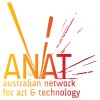Our language contains abundant metaphors drawn from the world of textiles. Craft based and media arts practices share a similar lineage as well as a technical skills base, combined with a sensibility that produces objects designed for human interaction. Both are designed to be experienced – played with, lived with, worn, used, touched and held rather than admired from afar.In this 21st century embedded computing and wearable technology have undergone a fashionable renaissance – however practicality hasn’t always taken priority. Take for example the luscious wearable fashion designs of Hussein Chalayan, which include a short animation projected through 15,600 LEDS and Swarovski crystals sewn into one dress. Chalayan, like many creatives today, works seamlessly across art, fashion and design, appearing to be equally comfortable showing at the Venice Biennale or Paris Fashion Week.
B ut this is hardly new – in 1956 Japanese avant-garde artist Atsuko Tanaka updated the rich textures and intricacies of the traditional kimono with the dazzling electric lights of the modern world. Her Electric Dress was composed entirely of light bulbs of all shapes, sizes and intense colours, and a plethora of connected electrical cords. Being a little dangerous as daily attire, it appeared mostly as a sculptural form -recently re-emerging as a central work exhibited at Documenta XII.
ut this is hardly new – in 1956 Japanese avant-garde artist Atsuko Tanaka updated the rich textures and intricacies of the traditional kimono with the dazzling electric lights of the modern world. Her Electric Dress was composed entirely of light bulbs of all shapes, sizes and intense colours, and a plethora of connected electrical cords. Being a little dangerous as daily attire, it appeared mostly as a sculptural form -recently re-emerging as a central work exhibited at Documenta XII.
This Filter is a companion to the Coded Cloth Exhibition and Catalogue held at the Samstag Museum of Art, and a survey of the field. The experimental wearable artworks of today artists will become pivotal in our understanding of how we are evolving as a culture and utilising new technologies. In Coded Cloth all of the artists use traditional textile practices to produce works that are far more functional than Chalayan or Tanaka’s constructions – exquisite works that are warming, growing, blossoming and singing in interaction with human beings.
And that’s what ANAT is all about – a network of people interacting. In 2009 we will be celebrating our 21st anniversary and will be bringing you the latest in emerging technologies, enabling artist’s and curators professional development, funding research and development in hybrid practices, embedding artists in science residencies, profiling experimental and electronic sound cultures, and creating dialogue around critical issues in cultural creativity and emerging artforms.
Please enjoy this issue of Filter magazine guest edited by Angella Mackey, who as an ANAT Curatorial Intern, contributed significantly to the Coded Cloth exhibition. I would especially like to thank Director Erica Green and Exhibitions Coordinator Emma Epstein at the excellent Samstag Museum of Art in Adelaide for their expansive vision, curatorial curiosity and artistic adventurousness in programming this jewel of a show. Lets hope that in 2009 more audacious and unconventional artforms emerge at galleries around the globe.
Wherever you are in the world, all of us at ANAT wish you, your families and your friends a very relaxing, peaceful, joyful, creative and connected holiday season.
Warmest wishes from the southern summer.
Melinda Rackham
Melinda was the Executive Director at ANAT from 2005 to 2009.
 This work is licensed under a Creative Commons Attribution-NonCommercial-ShareAlike 2.5 Australia.
This work is licensed under a Creative Commons Attribution-NonCommercial-ShareAlike 2.5 Australia.






